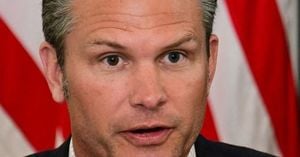As the clock ticks down toward a possible federal government shutdown, tensions in Washington have reached a fever pitch. With just days left before the funding deadline on September 30, 2025, Congress has found itself at a familiar crossroads—one marked by partisan standoffs, high-stakes negotiations, and the looming threat of shuttered federal offices. Lawmakers left town for a week-long recess after the Senate, on September 19, voted down two stopgap spending bills, including a Republican-backed “clean” continuing resolution (CR) that would have kept the government running for seven more weeks. Now, as the deadline approaches, all eyes are on Capitol Hill and the White House to see whether a deal can be struck in time to avert disruption.
According to The Hill, the crux of the standoff centers on healthcare—specifically, the fate of enhanced health insurance subsidies provided under the Affordable Care Act (ACA), which are set to expire at the end of the year. Democrats have made it clear they will not support the GOP’s clean CR without assurances that these subsidies will be extended. They argue that allowing them to lapse would result in a spike in premiums for millions of Americans, a risk they are unwilling to take. Senate Minority Leader Chuck Schumer (D-N.Y.) has been especially vocal, drawing a sharp contrast with his position in March 2025, when he shocked his party by backing a GOP-led spending bill. This time, Schumer insists, the situation is “much different now,” citing the unpopularity of the GOP’s tax and spending bill, Democratic unity, and recent rescissions by the Trump administration.
On the other side of the aisle, Republican leaders have doubled down on their message. Senate Majority Leader John Thune (R-S.D.) and House Speaker Mike Johnson (R-La.) have consistently pushed for their clean CR, framing it as the only responsible way to keep the government open while longer-term negotiations continue. Thune, speaking to The Hill, put it bluntly: “The choice is pretty clear. It’s going to be funding the government through a clean, short-term continuing resolution or a government shutdown.” After the Senate rejected the CR, Thune quickly moved to set up another vote for September 29, when lawmakers return from recess. He has also floated bills aimed at preventing future shutdowns and ensuring the military is paid even if the government closes.
The stakes are high and the blame game is already in full swing. Republicans, mindful of history, are eager to flip the script. In both 2013 and 2018, shutdowns orchestrated by the GOP over issues like the ACA and border wall funding left Republicans holding the bag in the court of public opinion. This time, Thune argues, Democrats are the ones trying to “add all this partisan stuff in,” referring to their insistence on healthcare provisions. “The times we’ve won, the Democrats are trying to add something. … They’re trying to add all this partisan stuff in,” Thune said, recently labeling the Democratic proposal “filthy.”
But Democrats are holding firm. According to the Associated Press, Senate Minority Leader Schumer and House Democratic Leader Hakeem Jeffries sent a letter to President Donald Trump on September 20, demanding a meeting to negotiate an end to what they called “your decision” to shut down the government. They accused Republicans, at Trump’s insistence, of refusing to engage in talks and warned that the Republican desire to “gut the healthcare of the American people” was at the heart of the crisis. “Democrats have been clear and consistent in our position,” they wrote. “We are ready to work toward a bipartisan spending agreement that improves the lives of American families and addresses the Republican healthcare crisis.”
President Trump, for his part, has so far kept his distance from the day-to-day negotiations, giving Thune and Johnson room to try to get the seven-week CR across the finish line. But he has not hesitated to assign blame. Speaking to reporters on September 19, Trump said, “You could very well end up with a closed country for a period of time.” He has insisted that the government will continue to “take care” of the military and Social Security payments in the event of a shutdown, but has pointed the finger squarely at Democrats for the impasse. When asked about the prospect of meeting with Democratic leaders, Trump replied, “I’d love to meet with them, but I don’t think it’s going to have any impact.”
The mechanics of the standoff are as complex as ever. The House managed to narrowly pass the Republican CR on a mostly party-line vote, but the measure failed in the Senate, where a 60-vote threshold requires bipartisan support. A Democratic proposal that would have boosted health care funds also failed. Republicans have indicated that while reversing Medicaid cuts (another Democratic demand) is a nonstarter, there may be room to address the expiring health insurance subsidies in the months ahead. Some Republicans, like retiring Senator Thom Tillis (R-N.C.), have signaled openness to a bipartisan fix before the December 31 deadline, potentially as part of a full-year funding bill later this year. Thune, too, has left the door open, telling reporters, “I think the ACA subsidies will be an issue that will be addressed, but I think right now we’ve got to keep the government open so we can do appropriations bills and work on that, with that solution.”
Meanwhile, the threat of a shutdown hangs over federal workers, military personnel, and millions of Americans who rely on government services. Questions abound: Will Democrats hold the line, or will pressure mount for a compromise? Can Republicans maintain their messaging discipline and avoid the pitfalls of past shutdowns? And what role will President Trump ultimately play in the final days before the deadline?
For now, there are no easy answers. Lawmakers will return to Washington on September 29, just one day before the government is set to run out of money. With both sides dug in and little trust to go around, the prospect of a last-minute deal remains uncertain at best. As Senator Peter Welch (D-Vt.) put it, “We’re united in our opposition here. There’s obviously real concern about any kind of shutdown. Democrats have always been in favor of passing legislation to keep the lights on, but we’re dealing in an uncharted territory here with a president who has made it clear — he favors a shutdown.”
As the deadline draws near, the nation watches and waits, hoping that Congress and the White House can find a way to keep the government open and avoid another costly and disruptive shutdown.




